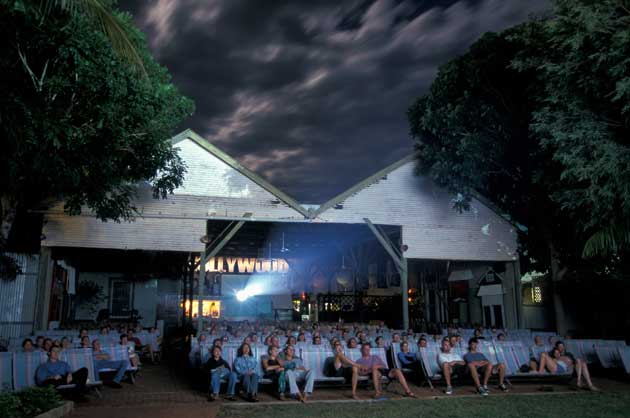Best for far-flung inspiration: Australia
From high-level trekking in Morocco's Atlas Mountains to rubbing shoulders with A-listers on Hollywood Boulevard, and from rural retreats off Tuscany's beaten track to jet-set hang outs for Moscow's super-rich, our writers have been to the ends of the earth to find a world of inspiration

At Cable Beach, near Broome in Western Australia, the sun is showing off again, setting the skies carelessly ablaze as it descends beneath the horizon. Onlookers linger until the last shadows have vanished from the broad sweep of pearly white sand, and the rust-red rocks that frame it. Renowned for its sublime sunsets, Cable Beach is one of the world's most beautiful strands. Part of its appeal, though, is its proximity to Broome, a town like no other in Australia, steeped in multiculturalism, perched in splendid isolation on the continent's far north-west coast and custodian of an exotic history as hub of the international pearl trade.
Reminders of that history are all over: the bronze statues in the main street; the corrugated iron buildings that once housed Chinese stores and opium dens; the Japanese cemetery, final resting-place of hundreds of divers who drowned or died of the bends; and Streeter's Jetty, protruding deep into mangroves, where the luggers would tie up and unload their precious cargo.
But compact, relaxed Broome is not merely a time capsule. Chinatown is lined with little shops and art galleries, and the town is disproportionately well endowed with excellent restaurants. Moreover, despite the tourists who triple the 15,000-strong population in the dry season, which coincides with the British winter, the place retains a distinct frontier feel. The nearest town to the north, Derby, is 120 miles away; to the south, 360 miles distant, lies Port Hedland. Tucked between the Great Sandy Desert and the Indian Ocean, Broome is closer to Indonesia than to Sydney or Perth.
The town, situated in the Kimberley region, was established in the 1880s after vast pearl oyster colonies were discovered off the coast. The first divers were Aborigines, many of whom were kidnapped, then brutally exploited and abused – forced to dive to dangerous depths. By the late 19th century, pearling masters, often the younger sons of English gentry, were recruiting men from China, Japan, the Malay peninsula and the Dutch East Indies for the difficult, perilous task of diving for mother-of-pearl – for it was the shell, used to make buttons, that was valued then; a pearl found inside was just a bonus.
The Japanese came to dominate the industry, which peaked in the early 1900s, when Broome supplied 80 per cent of the world's pearl shell. Man-made buttons eventually killed off the shell trade, but cultured pearls restored local fortunes, and today Broome pearls remain the world's most highly prized.
The town's rich multicultural past, meanwhile, is visible in the features of its inhabitants, who can point to a hotch-potch of ancestry – Japanese, Malay and Aboriginal, for instance. The annual Shinju Matsuri Festival of the Pearl celebrates Broome's particularly close links with Japan. Immigrant workers did suffer discrimination; they were confined to squalid foreshore camps, and when an outdoor cinema, Sun Pictures, opened in 1916, Asians and Aborigines had to use a separate entrance and sit at the back. Nevertheless, Broome evolved differently from other Australian towns, and nowadays it appears much more integrated than elsewhere, an oasis of relative racial harmony.
That cinema, incidentally, is the world's oldest operating picture garden, and is one of the great charms of Broome. Patrons recline on deck chairs under the stars, with the film occasionally interrupted by fruit bats flying across the screen.
Distant delights
* Stay on the "rooftop of the world". New tours to Ladakh, the "Little Tibet" region of the Indian Himalaya, offer inspirational views, trips to Buddhist monasteries and stays in traditional villages. An eight-night trip to Ladakh with Cazenove and Loyd (020-7384 2332; cazloyd.com) costs from £3,687pp
* Take an eight-day safari down the magnificent Yukon River in northern Canada. Pilot your own boat over 300 miles through pristine Yukon wilderness. Greatriverjourney.com
* Taiwan makes an appearance on intrepid travellers' "must-do" list as pioneering tour operators start to offer the Asian island as an adventure playground. Hike, bike and white-water raft the East Rift Valley or go ridge-top trekking at 4,000m along Mount Yushan. Tourism Taiwan (020-7928 1600; taiwan.net.tw)
* Explore Chile and Argentina's most spectacular wilderness regions, including the Perito Moreno Glacier and Torres del Paine on one of the new "In Depth" tours offered by Footloose Travel. Catering to "slow travellers", these overland trips aim to do more than scratch the surface of an inspirational destination. From £1,259 excluding flights (0845 330 6095; footloose.com)
Subscribe to Independent Premium to bookmark this article
Want to bookmark your favourite articles and stories to read or reference later? Start your Independent Premium subscription today.

Join our commenting forum
Join thought-provoking conversations, follow other Independent readers and see their replies